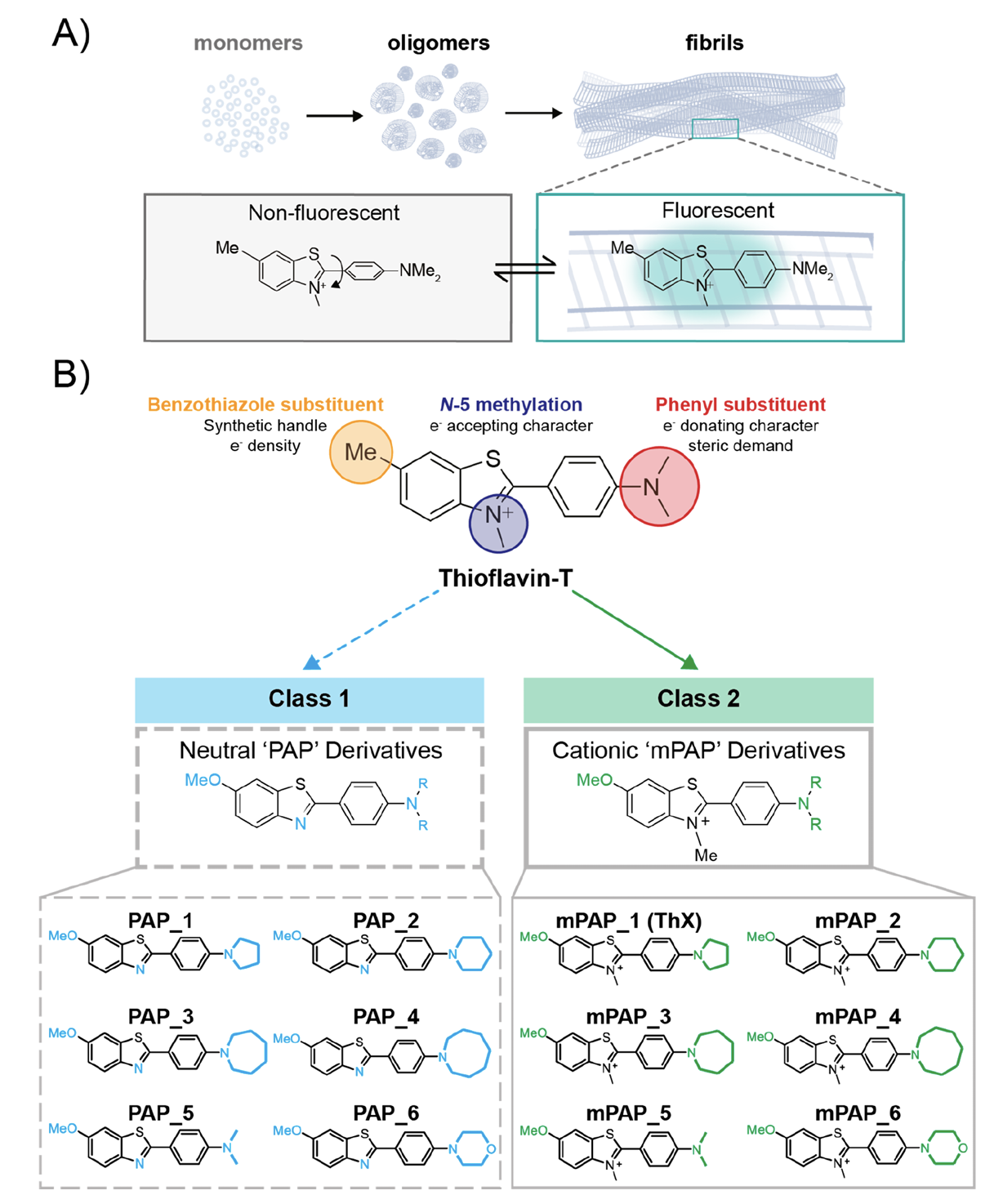
Next-generation fluorescent probes
Current work in TheLeeLab is directed at the ability to predict the photophysical properties of novel fluorophores as potential probes for super-resolution imaging applications.
Dyes for super-resolution imaging
TheLeeLab is part of an ongoing collaboration with Tom Snaddon's Lab (Indiana University Bloomington) developing new tools to optically probe protein structures. The new amyloid imaging dye, ThX (see Figure below) was designed and characterised by TheLeeLab and sythesised by the Snaddon lab, which you can read about it here. In short, the improved brightness of ThX over the conventional dye ThT has enabled better imaging of amyloid aggragated in the brain (which give rise to neurodegenerative diseases such as Parkinsons and Alzheimers). During the synthesis of ThX, other dyes were produced and showed interesting photophysical behaviour as documented here.

Development of Thioflavin-T derivatives. A) Schematic illustration of the nucleated pathway of amyloid fibril formation starting from monomeric proteins and the common cross-β sheet motif of amyloid fibrils to which benzothiazole salts bind transiently along the long fibril axis. The binding of ThX to the fibrils restricts the rotation around the carbon–carbon bond resulting in a fluorescence turn-on response. B) The two classes of novel ThT-inspired analogues characterized in this work: class 1, the neutral PAP derivatives and their Z = +1, benzothiazole N-methylated congeners; class 2, the mPAP derivatives.
Dyes for fluorescence lifetime imaging
We reported the novel derivative PAP_1 as a fluorescent lifetime probe for the detection of amyloid. By specifically using the fluorescence lifetime information, that is, the arrival time of single photons rather than the total number of photons, we were able to increase contrast in images of recombinant fibrils of α-synuclein (αSyn), the protein associated with Parkinson’s disease, artificially doped into autofluorescent brain tissue environments.

Tuning dye photophysics for volumetric super-resolution imaging
In single-molecule localisation microscopy, generation of a high-quality image depends on the measurement of many fluorescence events (localisations). In collaboration with Dr Aleks Ponjavic (University of Leeds) we have developed a new super-resolution technique called reservoir-PAINT (resPAINT).

Figure. PALM uses photoactivation of bound probes for SMLM, which achieves high contrast but finite localisation numbers. PAINT: In PAINT, probes transiently bind to targets, achieving unlimited localisations, although with increased background. resPAINT: With resPAINT, we combine active control of probe emission with PAINT to achieve practically unlimited localisations and high contrast (ka—association constant, kb—dissociation constant, ks—probe switching constant, kPB—photobleaching constant).
We use intermittently binding probes to allow the collection of an unlimited number of localisations, and tune the fluorophore photophysics to ensure the vast majority of probes are non-emissive while not bound to the target. This allows us to use higher probe concentrations and enables up to a 50-fold improvement in localisation rate for a similar fluorescent background, facilitating collection of high-fidelity 3D super-resolution images in minutes as opposed to multiple hours.
